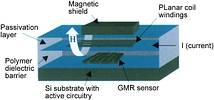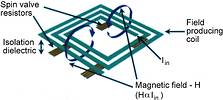
IsoLoop is the trademark name for NVE's family of isolation products. IsoLoop devices are created with giant magnetoresistive materials or GMR. When magnetic thin film layers separated by nonmagnetic thin film layers are subject to a magnetic field generated by a directional current, a change in resistance takes place in the magnetic thin films.
Construction
In high-speed data transmission systems, data integrity can only be maintained where there is low pulsewidth distortion. The advantages of these isolators are that the 2 ns pulsewidth distortion specification gives very high-speed capabilities and the sub 10 ns propagation delays and 2 ns propagation delay skews gives them a DC performance no other isolator is capable of.

Figure 1 illustrates that a change in input current through the on-chip coil creates a magnetic field that changes the state of the resistor between low and high to create a logic 1 or logic 0. The structure is fabricated adjacent to standard silicon integrated circuits to create the isolated logic functions as shown in Figure 2. This building block isolator is then used to build a wide range of standard isolated logic functions. The first IsoLoop logic product released by NVE was the IL710, a 100 Mbaud data rate part. In this SOIC-8 version, since the isolator is die-sized, the package choice for products is essentially pad limited. Higher levels of integration are now available than was previously possible.

True isolated logic functions are achieved in almost the same sized packages as the original nonisolated logic function, without the need for extra surrounding components required to complete the desire function. Only two additional power supply pins, needed on the isolated side, add to the total pin count. According to NVE, small size, high performance and low cost make the IsoLoop technology highly versatile and adaptable for isolation applications.
Applications
Due to the high performance of the IsoLoop products, the range of possible applications is large. The IL485 meets the requirements of Profibus, and using IL710s or the IL712 with a CAN-approved device meets that standard's propagation delay requirements. The IL422 provides the same performance as the IL485; low distortion and propagation delay, but functions as a full-duplex transceiver. The IL422 and IL485 devices are capable of data transmission rates of 25 and 35 MB at 10% PWD respectively. The multichannel feature of the IL715/716/717 devices offers a true bidirectional capability, providing the isolation designer the capability to isolate ADC interfaces, PGA gain, control loops and multi-phase control systems.
All the IsoLoop products have a 20 kV/ms minimum transient immunity specification making them ideal for motor control applications. All are also approved to UL1577.

© Technews Publishing (Pty) Ltd | All Rights Reserved